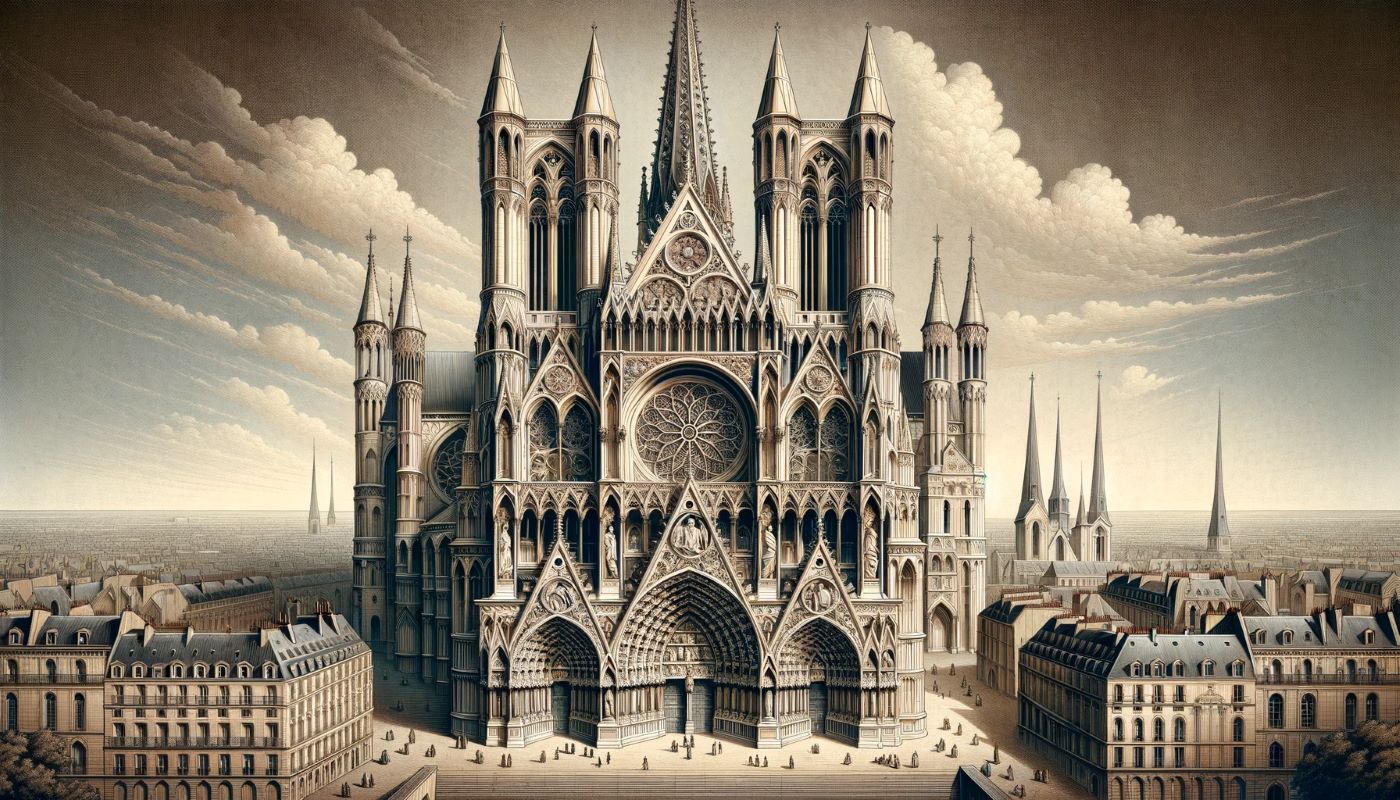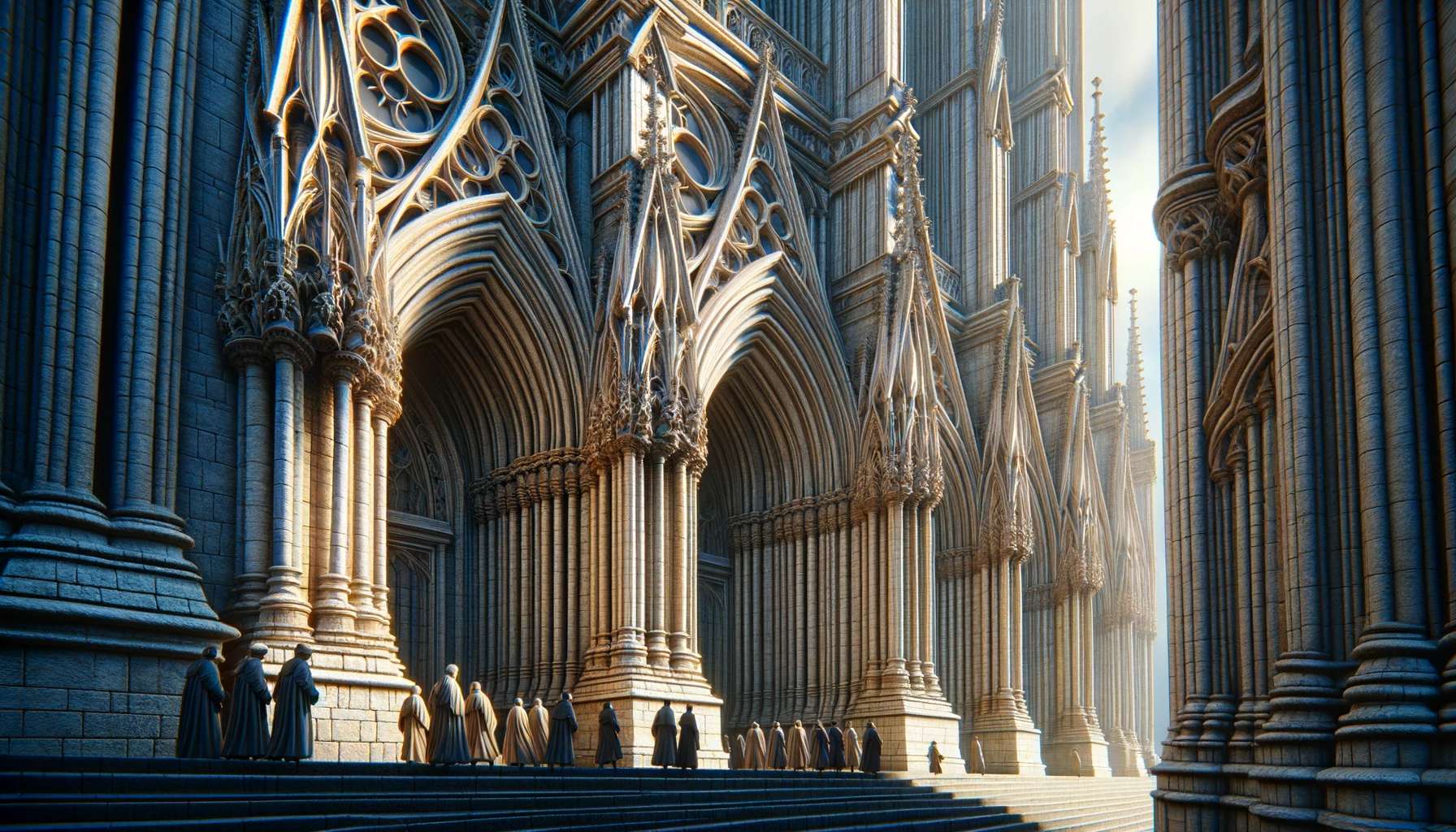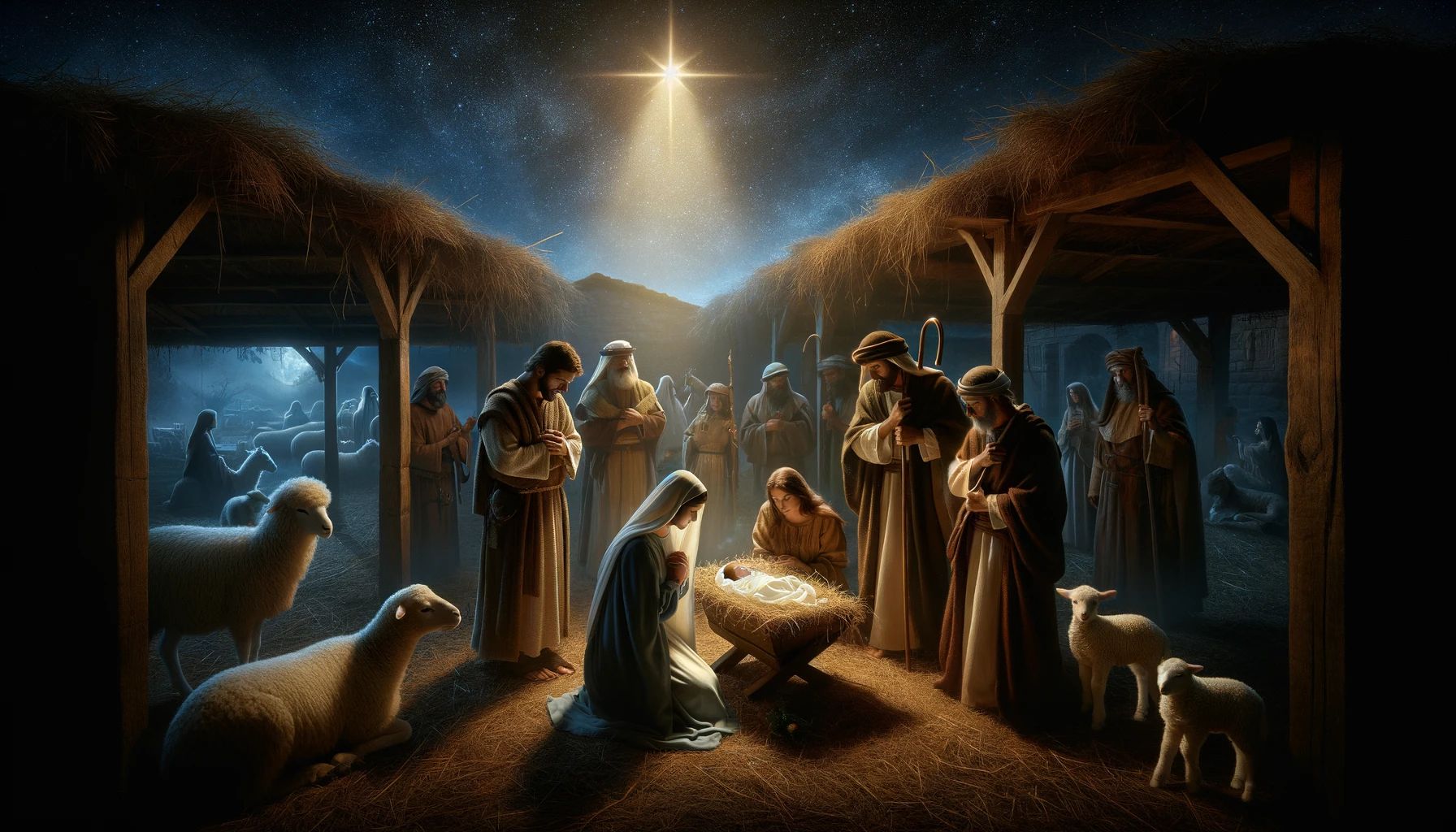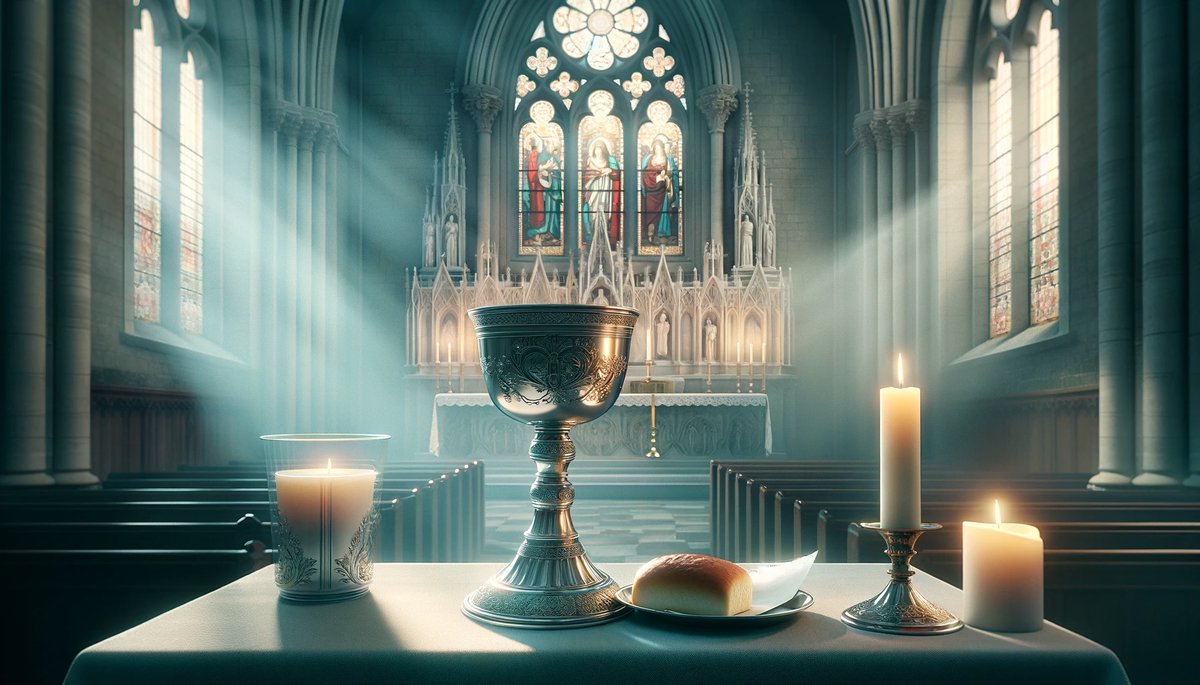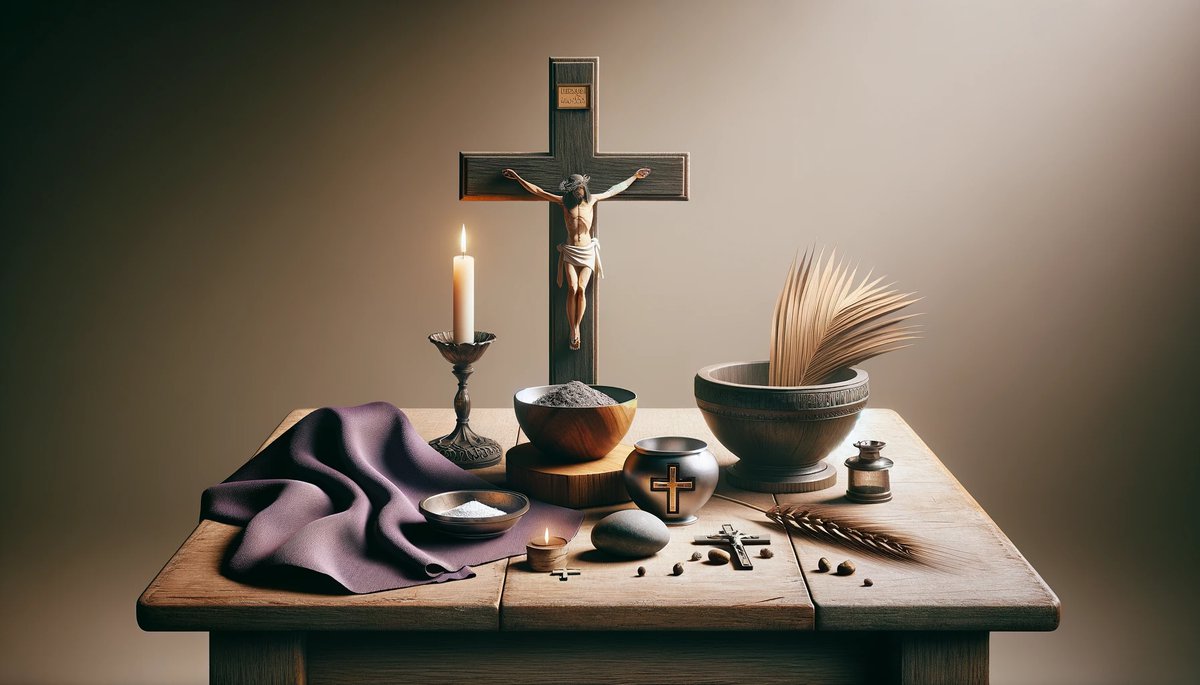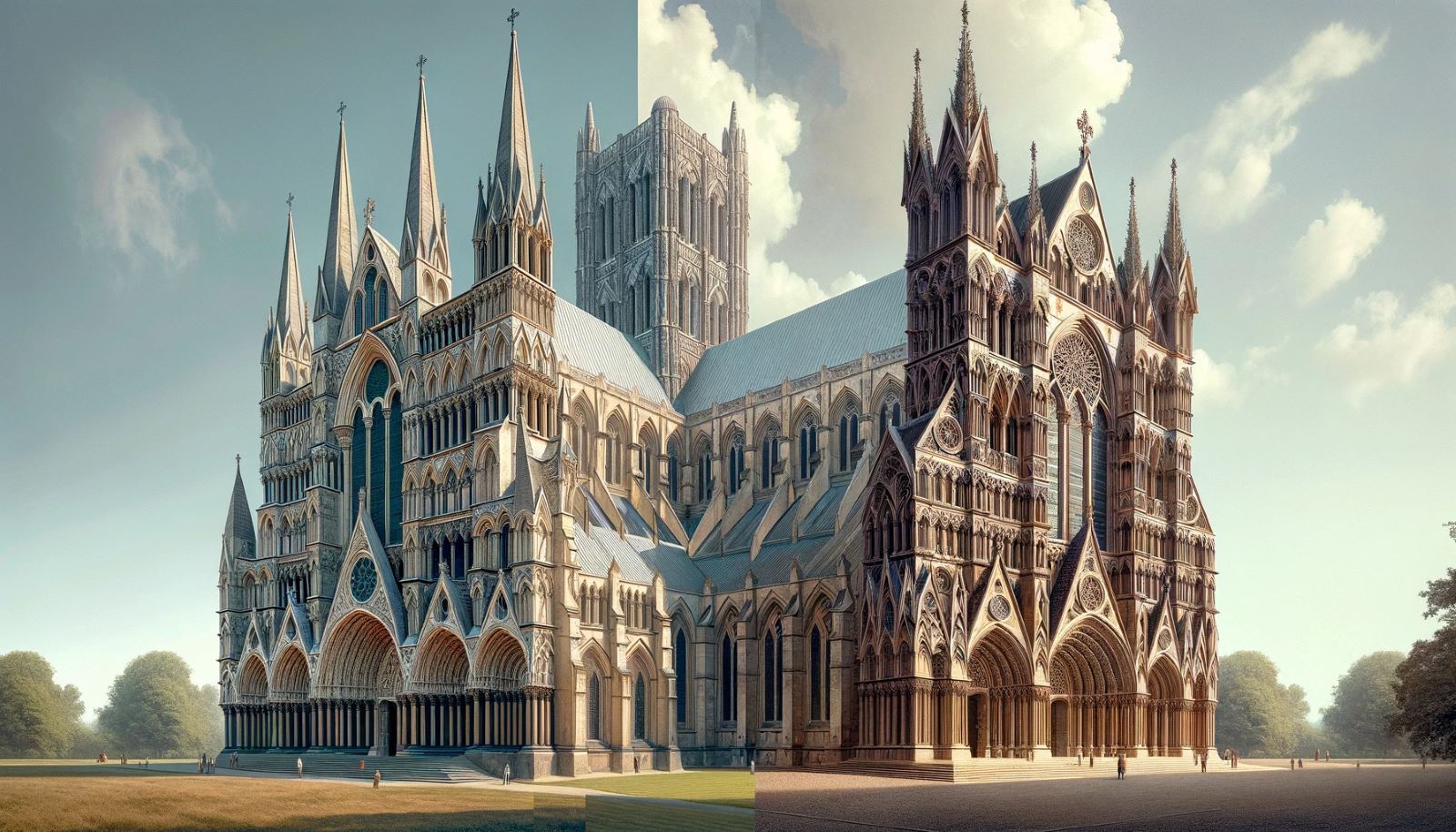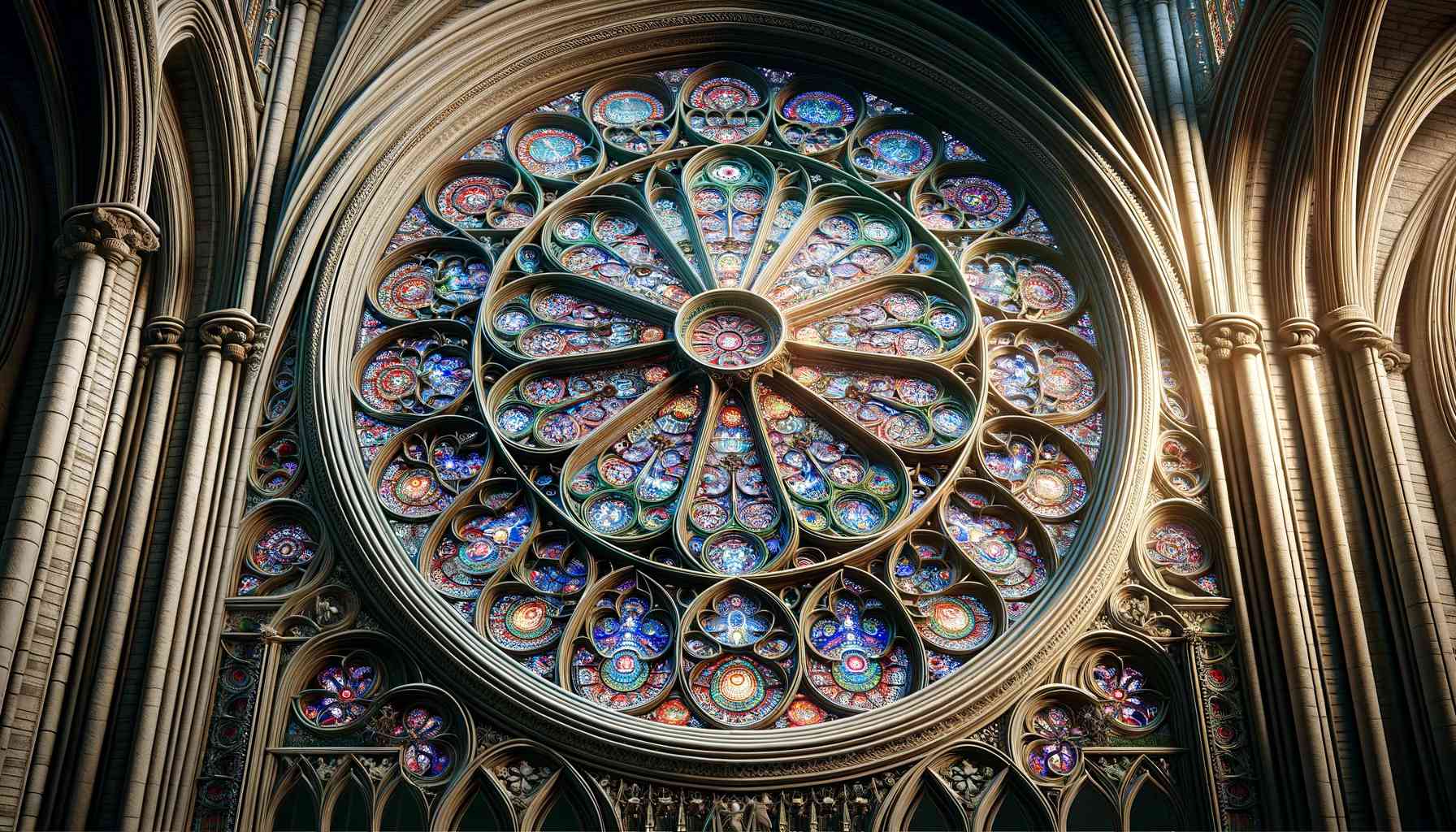Home>Arts and Culture>What Did A Gothic Cathedral Symbolize


Arts and Culture
What Did A Gothic Cathedral Symbolize
Published: February 15, 2024
Jason DeRose, Managing Editor at Christian.net, uses his expertise in religion and journalism to deepen understanding of faith's societal impacts. His editorial leadership, coupled with a strong academic background, enriches the platform’s diverse content, earning him recognition in both journalism and religious circles.
Discover the symbolic significance of Gothic cathedrals and their impact on arts and culture. Explore the rich history and meaning behind these architectural marvels.
(Many of the links in this article redirect to a specific reviewed product. Your purchase of these products through affiliate links helps to generate commission for Christian.net, at no extra cost. Learn more)
Table of Contents
Introduction
Gothic cathedrals stand as timeless marvels of human ingenuity and spiritual devotion. These architectural wonders, with their soaring spires, intricate stone carvings, and ethereal stained glass windows, continue to captivate and inspire awe in visitors from around the world. The term "Gothic" might evoke images of darkness and mystery, but these cathedrals are anything but gloomy; rather, they are radiant with light and symbolism.
From the grandeur of Notre-Dame de Paris to the majestic beauty of Chartres Cathedral, these structures are not merely buildings; they are profound expressions of faith, artistry, and the human spirit. As we delve into the historical and symbolic significance of Gothic cathedrals, we will uncover the rich tapestry of meanings woven into their very foundations.
These architectural masterpieces emerged during the medieval period, a time of great religious fervor and artistic innovation. The construction of Gothic cathedrals was a monumental endeavor that spanned decades, often outlasting the lifetimes of those who initiated them. The sheer scale and intricacy of these edifices reflect the unwavering dedication of the craftsmen and artisans who poured their hearts and souls into every stone, arch, and sculpture.
As we embark on this exploration, we will unravel the layers of symbolism embedded in the design and ornamentation of these cathedrals. Beyond their religious significance, these structures also served as powerful symbols of societal values, political influence, and communal identity. Each facet of their construction, from the pointed arches to the towering spires, carries profound meaning that transcends mere architectural aesthetics.
Join me on this journey through time and space as we uncover the profound symbolism and spiritual significance of Gothic cathedrals, delving into the intricate details that have fascinated and inspired generations of admirers. Let us unravel the mysteries and meanings hidden within the stone walls and soaring heights of these extraordinary monuments to human creativity and faith.
Read more: What Makes A Gothic Cathedral
Historical Background of Gothic Cathedrals
The emergence of Gothic cathedrals can be traced back to the 12th century, a time of profound transformation in European society. This period, known as the High Middle Ages, witnessed a resurgence of urbanization, trade, and intellectual inquiry, laying the groundwork for a remarkable era of architectural innovation. Prior to the Gothic style, Romanesque architecture prevailed, characterized by thick walls, small windows, and a sense of massiveness. However, as the medieval populace sought to express their burgeoning faith and devotion, a new architectural language began to take shape.
The birth of the Gothic style can be attributed to the construction of the Abbey Church of St. Denis near Paris, France, under the patronage of Abbot Suger. This visionary leader sought to create a space that embodied the ethereal qualities of light and transcendence, departing from the dark and heavy aesthetic of Romanesque architecture. The innovative use of pointed arches, ribbed vaults, and flying buttresses allowed for greater height and luminosity within the sacred space, symbolizing a spiritual ascent towards the divine.
The architectural advancements pioneered at St. Denis soon reverberated across Europe, igniting a fervent wave of cathedral construction. From the grand cathedrals of Chartres and Notre-Dame to the awe-inspiring edifices of Reims and Amiens, the Gothic style flourished, becoming the hallmark of medieval ecclesiastical architecture. The construction of these monumental structures was not merely an act of religious devotion; it was also a testament to the growing influence and prosperity of burgeoning urban centers.
The intricate process of building a Gothic cathedral was a communal endeavor, involving the collaboration of skilled stonemasons, craftsmen, and artisans. The construction often spanned several generations, with each successive cohort adding their own mark to the evolving masterpiece. The cathedral became a focal point of civic pride and communal identity, reflecting the aspirations and achievements of the towns and cities that embraced these ambitious projects.
As the Gothic style continued to evolve, it transcended the realm of religious architecture, influencing the design of civic buildings, universities, and palaces. Its impact extended far beyond the medieval period, leaving an indelible mark on the architectural landscape of Europe and beyond. The legacy of Gothic cathedrals endures as a testament to the creative spirit and unwavering faith of those who envisioned and realized these transcendent structures.
The historical background of Gothic cathedrals is a testament to the convergence of artistic vision, spiritual fervor, and communal endeavor, shaping the cultural landscape of medieval Europe and beyond.
Architectural Features of Gothic Cathedrals
Gothic cathedrals are renowned for their distinctive architectural elements, each meticulously crafted to evoke a sense of divine grandeur and spiritual transcendence. These awe-inspiring structures exhibit a remarkable fusion of technical innovation and symbolic expression, setting them apart as timeless marvels of human creativity.
1. Pointed Arches and Ribbed Vaults
One of the defining features of Gothic cathedrals is the extensive use of pointed arches and ribbed vaults. Unlike the rounded arches of Romanesque architecture, the pointed arches of Gothic cathedrals allowed for greater height and verticality, creating a sense of upward movement and aspiration. The ribbed vaults, intersecting in a delicate network of stone, distributed the weight of the ceiling, enabling the construction of soaring, open interiors flooded with light.
2. Flying Buttresses
The introduction of flying buttresses revolutionized architectural engineering, enabling the construction of expansive stained glass windows and lofty ceilings. These external masonry supports, resembling graceful arches, transferred the lateral thrust of the vaulted ceilings to the outer walls, allowing for the creation of expansive clerestory windows. The interplay of light and shadow through these luminous windows imbued the interior spaces with an ethereal quality, evoking a sense of divine illumination.
3. Stained Glass Windows
Gothic cathedrals are renowned for their resplendent stained glass windows, which served as visual narratives of biblical stories and sacred teachings. These vibrant windows, often depicting scenes from the Old and New Testaments, illuminated the interior spaces with a kaleidoscope of colors, infusing the sacred environment with a sense of otherworldly beauty. The interplay of light through the stained glass created a transcendent ambiance, inviting worshippers to contemplate the divine mysteries in a space suffused with radiant hues.
4. Sculptural Ornamentation
The façades and interiors of Gothic cathedrals are adorned with intricate sculptural details, depicting a myriad of religious figures, saints, and biblical motifs. Every column, capital, and tympanum serves as a canvas for the expression of divine narratives and spiritual symbolism. The delicate carvings and sculptures, meticulously crafted by skilled artisans, imbue the cathedrals with a sense of sacred storytelling, inviting visitors to contemplate the profound mysteries of faith and salvation.
5. Towering Spires
The soaring spires of Gothic cathedrals reach towards the heavens, symbolizing the human aspiration for transcendence and spiritual elevation. These majestic towers, often crowned with intricate tracery and delicate pinnacles, stand as testaments to the enduring quest for divine connection. The spires, visible from afar, served as beacons of faith, drawing pilgrims and worshippers towards the sacred heart of the cathedral.
The architectural features of Gothic cathedrals, from their soaring arches to resplendent stained glass, converge to create an immersive environment that transcends the material world, inviting visitors to embark on a spiritual journey through the ethereal realms of faith and beauty.
Symbolism in Gothic Cathedral Design
The design of Gothic cathedrals is imbued with profound symbolism, each architectural element and ornate detail serving as a conduit for spiritual and allegorical expression. From the soaring heights of the spires to the intricate tracery of the stained glass windows, every facet of these sacred edifices carries layers of meaning that transcend mere aesthetic beauty.
1. Vertical Ascent and Divine Aspiration
The verticality of Gothic cathedrals, achieved through the use of pointed arches, ribbed vaults, and soaring spires, symbolizes the human aspiration for spiritual elevation and transcendence. The upward movement of the architecture reflects the yearning of the soul to ascend towards the divine, mirroring the metaphorical journey from earthly concerns to heavenly realms. As visitors gaze upwards, they are invited to contemplate the ineffable mysteries of faith and the eternal pursuit of spiritual enlightenment.
2. Light and Illumination
The luminous interiors of Gothic cathedrals, illuminated by resplendent stained glass windows, evoke the divine presence and the transformative power of spiritual illumination. The interplay of light and color within the sacred space symbolizes the radiant grace of God, infusing the environment with a sense of ethereal beauty and transcendence. The kaleidoscopic hues filtering through the stained glass serve as visual allegories of divine revelation, inviting worshippers to bask in the ineffable radiance of the divine presence.
3. Sacred Geometry and Harmony
The harmonious proportions and geometric precision of Gothic architecture reflect a profound sense of cosmic order and divine harmony. The intricate tracery of the rose windows, the rhythmic repetition of arches and columns, and the symmetrical layout of the floor plan allude to the timeless principles of divine creation and cosmic balance. Visitors are enveloped in an environment where every line and curve speaks to the inherent order and beauty of the universe, inviting contemplation of the divine wisdom that governs all creation.
4. Spiritual Journeys and Pilgrimage
Gothic cathedrals served as physical and spiritual waypoints for pilgrims embarking on sacred journeys. The labyrinthine layouts of some cathedrals, such as Chartres, symbolize the arduous yet transformative path of the pilgrim towards spiritual enlightenment and salvation. The cathedral becomes a microcosm of the pilgrim's spiritual odyssey, guiding them through a labyrinth of faith, penance, and ultimately, divine communion.
5. Communal Identity and Collective Faith
The construction of Gothic cathedrals was a communal endeavor, reflecting the collective aspirations and faith of the communities that built them. The cathedrals served as symbols of civic pride, communal identity, and the enduring faith of the populace. Every stone laid and every sculpture carved was an expression of communal devotion and a testament to the enduring legacy of faith that transcended individual lifetimes.
In essence, the symbolism woven into the design of Gothic cathedrals transcends mere architectural aesthetics, inviting visitors to embark on a profound journey of spiritual contemplation and divine revelation. These sacred spaces stand as testaments to the enduring quest for transcendence and the timeless allure of the divine.
Religious and Spiritual Significance
The religious and spiritual significance of Gothic cathedrals transcends their physical presence, encompassing profound layers of symbolism and allegory that invite visitors into a sacred realm of divine contemplation and spiritual revelation. These architectural marvels were conceived as embodiments of faith, serving as conduits for the transcendent mysteries of the divine.
At the heart of their religious significance lies the aspiration to create a physical manifestation of the heavenly Jerusalem, a celestial archetype that symbolizes the ultimate union between God and humanity. The soaring spires, luminous stained glass, and ethereal interiors of Gothic cathedrals were crafted to evoke the celestial realms, inviting worshippers to partake in a foretaste of the divine glory. As visitors crossed the threshold of these sacred spaces, they were enveloped in an environment that transcended the mundane, beckoning them to contemplate the ineffable mysteries of faith and salvation.
The architectural elements of Gothic cathedrals, such as the pointed arches and ribbed vaults, were not merely feats of engineering; they were expressions of spiritual ascent and divine elevation. The upward movement of the architecture symbolized the soul's yearning for transcendence, mirroring the metaphorical journey from earthly concerns to heavenly realms. As worshippers gazed upwards, they were drawn into a contemplative state, pondering the eternal truths and spiritual aspirations that lay beyond the material world.
The resplendent stained glass windows, aglow with vibrant hues, served as visual allegories of divine revelation and spiritual illumination. The interplay of light and color within the sacred space evoked the radiant grace of God, infusing the environment with a sense of ethereal beauty and transcendence. As sunlight filtered through the stained glass, it painted the interiors with a kaleidoscope of hues, inviting worshippers to bask in the ineffable radiance of the divine presence.
Moreover, the cathedrals' labyrinthine layouts, such as the famous labyrinth at Chartres, symbolized the arduous yet transformative path of the pilgrim towards spiritual enlightenment and salvation. The cathedral became a microcosm of the pilgrim's spiritual odyssey, guiding them through a labyrinth of faith, penance, and ultimately, divine communion.
In essence, the religious and spiritual significance of Gothic cathedrals lies in their ability to transcend the material realm, inviting visitors to embark on a profound journey of spiritual contemplation and divine revelation. These sacred spaces stand as testaments to the enduring quest for transcendence and the timeless allure of the divine.
Social and Political Symbolism
Beyond their religious and spiritual significance, Gothic cathedrals also served as powerful symbols of social and political influence, reflecting the aspirations, values, and power dynamics of medieval society. These monumental edifices were not isolated from the broader social and political landscape; rather, they were integral to the fabric of communal identity, civic pride, and the assertion of authority.
1. Urban Centers and Economic Prosperity
The construction of Gothic cathedrals often coincided with the rise of burgeoning urban centers, serving as tangible expressions of the economic prosperity and cultural vitality of these communities. The cathedrals stood as iconic landmarks, signaling the growing influence and affluence of the towns and cities that embraced these ambitious architectural projects. Their towering spires and resplendent facades became emblems of urban pride, symbolizing the collective achievements and aspirations of the populace.
2. Patronage and Political Authority
The sponsorship and patronage of Gothic cathedrals by monarchs, nobility, and ecclesiastical authorities underscored the intertwining of religious and political power. The construction of these grand edifices was often supported by royal and aristocratic patrons, who sought to align themselves with the divine authority and legitimize their own positions of power. The cathedrals became potent symbols of political patronage and authority, serving as tangible expressions of the close relationship between church and state.
3. Communal Identity and Collective Endeavor
The communal effort involved in the construction of Gothic cathedrals fostered a sense of collective identity and civic pride within the communities that undertook these ambitious projects. The labor of skilled stonemasons, craftsmen, and artisans, often supported by the broader populace, reflected a shared commitment to the realization of a transcendent vision. The cathedrals became focal points of communal identity, embodying the collective faith, aspirations, and cultural heritage of the towns and cities that embraced them.
4. Artistic Innovation and Cultural Expression
The architectural and artistic innovations of Gothic cathedrals reflected the cultural and intellectual dynamism of medieval society. The intricate tracery of the stained glass windows, the delicate carvings adorning the facades, and the harmonious proportions of the interiors spoke to a burgeoning spirit of artistic expression and creative ingenuity. The cathedrals became showcases of cultural achievement, embodying the aesthetic and intellectual aspirations of the communities that nurtured them.
In essence, the social and political symbolism of Gothic cathedrals transcends their religious function, encapsulating the multifaceted dynamics of medieval society. These monumental structures stand as enduring testaments to the interplay of faith, power, and communal identity, reflecting the timeless allure and enduring legacy of Gothic architecture.
Conclusion
In conclusion, Gothic cathedrals represent an extraordinary fusion of religious, spiritual, social, and political symbolism, transcending their roles as mere architectural marvels. These monumental edifices, with their soaring spires, resplendent stained glass, and intricate sculptural ornamentation, stand as enduring testaments to the creative spirit and unwavering faith of medieval society.
The historical background of Gothic cathedrals reveals a period of profound transformation and artistic innovation, where the construction of these sacred structures mirrored the burgeoning urbanization and cultural vitality of medieval Europe. The architectural features of Gothic cathedrals, from the pointed arches to the flying buttresses, reflect a remarkable marriage of technical ingenuity and spiritual expression, inviting visitors to embark on a journey through the ethereal realms of faith and beauty.
The symbolism woven into the design of Gothic cathedrals speaks to the timeless aspirations of the human spirit, evoking themes of divine aspiration, spiritual illumination, cosmic harmony, and communal identity. These sacred spaces transcend the material world, inviting visitors to contemplate the ineffable mysteries of faith and salvation, and to partake in a foretaste of the divine glory.
Moreover, Gothic cathedrals served as potent symbols of social and political influence, reflecting the economic prosperity, political patronage, and communal endeavor of the societies that built them. These monumental edifices became iconic landmarks, embodying the collective achievements and aspirations of the towns and cities that embraced them, and serving as tangible expressions of the close relationship between church and state.
In essence, Gothic cathedrals stand as enduring testaments to the enduring quest for transcendence and the timeless allure of the divine. As visitors cross the threshold of these sacred spaces, they are enveloped in an environment that transcends the mundane, beckoning them to contemplate the enduring legacy of Gothic architecture and the profound mysteries hidden within the stone walls and soaring heights of these extraordinary monuments to human creativity and faith.
